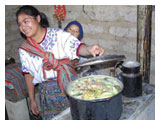Plant oil-powered stove catches Gloria’s fancy
Manila Standard Today, Philippines, May 19, 2006
President Gloria Macapagal Arroyo yesterday ordered the mass production and distribution of a new cooking device that runs on oil harvested from plants to 18 “hotspot” urban poor areas all over the country.
Mrs. Arroyo said the Leyte State University should fast track the production of Protos, which can run on jatropha oil, among other plant-based oil products, to help Filipino consumers cope with the rising cost of living.
“We will support the mass production and distribution of this cooking oil in 18 hotspots in the country to benefit those living in urban poor areas,” she said.
The Leyte State University is producing Protos, which is manufactured by German firms Bosch and Siemens Home Appliances Group.
Mrs. Arroyo said while the introductory price at P2,000 may be considered prohibitive, mass production will eventually lower the price of the plant oil-powered appliance.
Protos, also known as jatropha stove, was officially launched in Malacañang yesterday.
The President also ordered the immediate release of P500 million for the Philippine National Oil Co. for the planting of jatropha plants, locally known as tuba-tuba or tubang-bakod.
Socioeconomic Planning Secretary Romulo Neri said the country imports about $7 billion worth of oil and petroleum products, 25 percent of which is diesel. Once the jatropha methyl ester product is mass-produced, it can translate to a savings of $1.75 billion.
The PNOC and the Armed Forces have signed an agreement for the conversion of idle lands in military camps into plantations for jatropha, a potential biofuel source.
Another P500 million will be sourced from National Development Co. for the mass production of jatropha cooking oil and jatropha methyl ester as an alternative gasoline blend.
Lt. Gen. Romeo Tolentino of the Northern Luzon Command said 150 hectares have been allotted by the Armed Forces for the test planting of jatropha.
The Camarines Sur provincial government has also set aside 10,000 hectares of land in the towns of Lagonoy, Caramoan, Presentacion, Pili, Calabanga and Sipocot to serve as jatropha farms.
According to Jun Lozada, president of the Philippine Forest Corp. which is a subsidiary of the Department of Environment and Natural Resources, about P50 million of the P500 million PNOC budget will be used for further research.
“Per hectare, a jatropha farmer can earn P10,000 to P15,000 for the first year, and after five years that will plateau at P60,000 per hectare,” Lozada said.
Neri, however, gave a conservative view on the private production of jatropha oil products. “Let’s give it one year with the Philippine Army first. I do not want to be overoptimistic because this is still in the testing stage although some people are making glowing remarks over this.”
Jatropha planted from seedlings would start yielding fruits after six months, while those planted from cuttings would have an earlier yield at one to two months.
The University of the Philippines-Los Baños is now developing the protocol for the tissue culture of jatropha to mass produce the plant cuttings.
UPLB aims to come up with a high-quality jatropha seedling that is free from viruses, bacteria and fungi.
